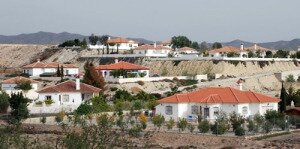Article in NY Times
Demolitions Show Andalusian Nightmare Lingers
Despite Government Decree, Owners of Illegal Homes Still Worry

ALBOX, Spain — Driving through the Andalusian countryside, Maura Hillen pointed past groves of olive trees to small clusters of white houses on a distant hillside.
“Those homes are all illegal and could be demolished,” said Ms. Hillen, who moved here from Britain 10 years ago with her husband, John.
More than 5,000 homes in this rustic valley are illegal, part of the more than 250,000 homes built in Andalusia without proper planning permission during the Spanish construction boom of 2001 to 2008. Thousands were sold, some to locals and many to international buyers, including the Hillens, who wanted to retire amid the region’s picturesque landscape of palms trees and farmhouses of crumbling stone.
Instead they have been embroiled in a 10-year battle over the future of their retirement homes, a struggle many believe will not be settled soon. Officials and developers have been sent to prison for their roles in the scandal, but there has not been any decision on what to do about the houses, which have no legal status and could be torn down at any time.

In recent months there had been signs of progress, with both the courts and local government officials acknowledging the need for a solution. But in November two homes owned by British couples outside the town of Cantoria were demolished.
“The authorities have been torturing homeowners for years with the threats of demolition, killing us softly with pieces of paper and procedures and regulations and plans,” said Ms. Hillen, who is president of Abusos Urbanisticos Almanzora No, a group of about 600 homeowners fighting to save the homes.
Headlines in the European press about demolitions and court battles have left a black cloud over the second-home market in the region, which is struggling to recover after Spain’s property crash. Prices in the country are down more than 40 percent since the peak of the market in 2007, according to Tinsa, a Spanish appraisal company.
Sales activity is picking up in Marbella and other coastal resorts, but remains sluggish in the hills of Andalusia, where buyers are looking for bargains.
“Many of our clients, especially the Spanish and Belgian ones, see the bad news about illegal houses from a positive angle, to get prices reduced even further,” said Stephen Garner, sales director of Spanish Property Choice, a real estate agency.
Tom Jones, 74, recently was offered 30,000 euros, or about $37,000, for his three-bedroom house in Alhambra, which he bought for €195,000 in 2005.
Although he has been waiting for three years for his court case challenging the demolition order to be heard, he decided not to sell. “We’re fighting this all the time,” Mr. Jones said. “Progress? I don’t believe any of it. Lot of rubbish.”
In 2012 the regional government approved a decree designed to provide a way to avoid demolitions. But in two years only a few hundred homeowners have gone through the process and successfully changed the status of their homes, according to government officials.
The decree has “a big hole,” said Gerardo Vázquez, an attorney representing homeowners. “It only covers, at best, individual houses or large developments.” Thousands of homes in small developments and subdivided parcels in rural areas were not included.
Also, the decree relied on municipalities to develop specific plans, a process that homeowners fear could take years.
Owners claimed a victory in October when a judge ordered a halt to the demolition of four homes and, for the first time, awarded the owners a total of 140,000 euros, or about $174,000, in “moral damages” for the years they had lived with the threat of demolition.
“We’re relieved,” said Roger Harvey, 69, one of the owners. “But we’re angry it has taken 10 years to get to this stage.”
Despite the ruling, the status of Mr. Harvey’s three-bedroom villa still is not clear. While it cannot be demolished, it is not considered legal and cannot be resold. Since it is not legal, it is not eligible for utilities; the Harveys use a generator for power and water is brought to the home by a tanker.
“We can’t move. We can’t sell,” Mr. Harvey said. “All of our savings are into this.”
The future of the illegal homes is a hot political topic in Andalusia. Government officials say they are ready to support new legislation that would change the law and legitimize the homes.
“I’m optimistic,” said José Luis Sánchez Teruel, secretary general in Almería of the PSOE, the socialist majority party in Andalusia. “There is political will to resolve the issue.”
But several hurdles remain. Environmentalists argue that homes on public land should be removed, regardless of the owner’s status. There is also the sticky issue of compensation for owners of homes that are demolished.
Many homeowners, like Brian Reade, are skeptical that the issues will be resolved anytime soon.
Mr. Reade recently received notice that the Andalusian government was starting the process to demolish his home. He believed all the proper paperwork was in place when he paid €240,000 in 2006 for a detached villa under construction in Zurgena, in the Almazora Valley.
But Mr. Reade’s home has been caught in the middle of a criminal investigation of the Zurgena town hall.
“Generally, we’re just going around in circles,” he said. “I don’t feel confident I will ever be able to sit in my armchair and say, ‘This is the end of it.”’
Article by; Keving Brass
The New York Times



